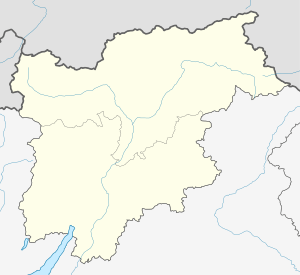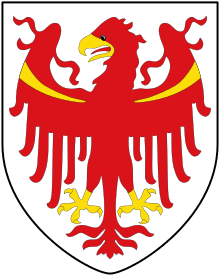Schenna
Schenna (German pronunciation: [ˈʃɛna]; Italian: Scena [ˈʃɛːna]) is a comune (municipality) in South Tyrol in northern Italy, located about 25 kilometres (16 mi) northwest of the city of Bolzano.
Schenna | |
|---|---|
| Gemeinde Schenna Comune di Scena | |
 A panorama of Schenna | |
Location of Schenna 
| |
 Schenna Location of Schenna in Italy  Schenna Schenna (Trentino-Alto Adige/Südtirol) | |
| Coordinates: 46°41′N 11°11′E | |
| Country | Italy |
| Region | Trentino-Alto Adige/Südtirol |
| Province | South Tyrol (BZ) |
| Frazioni | Schennaberg (Montescena), Tall (Valle), Verdins |
| Government | |
| • Mayor | Alois Kröll |
| Area | |
| • Total | 48.2 km2 (18.6 sq mi) |
| Elevation | 600 m (2,000 ft) |
| Population (Nov. 2010)[2] | |
| • Total | 2,841 |
| • Density | 59/km2 (150/sq mi) |
| Demonym(s) | German: Schennaner Italian: di Scena |
| Time zone | UTC+1 (CET) |
| • Summer (DST) | UTC+2 (CEST) |
| Postal code | 39017 |
| Dialing code | 0473 |
| Website | Official website |
Geography
As of 30 November 2010, it had a population of 2,841 and an area of 48.2 square kilometres (18.6 sq mi).[3]
Schenna borders the following municipalities: Hafling, Kuens, Merano, Riffian, St. Leonhard in Passeier, Sarntal, and Tirol.
Frazioni
The municipality contains the frazioni (subdivisions, mainly villages and hamlets) Schennaberg (Montescena), Tall (Valle), and Verdins.
History
Origin
In the Middle Ages an important castle was built. Archduke Johann of Austria acquired it in 1845. In the 1970s, 1980s and 1990s many festivals took place inside it, but now, for health and safety reasons (since there was no emergency exit) there are no more.
Inside the castle, known as "Schloss Schenna" Andreas Hofer's cot is to be found.
Society
Linguistic distribution
According to the 2011 census, 98.18% of the population speak German, 1.67% Italian and 0.15% Ladin as first language.[5]
Demographic evolution

References
- "Superficie di Comuni Province e Regioni italiane al 9 ottobre 2011". Istat. Retrieved 16 March 2019.
- "Popolazione Residente al 1° Gennaio 2018". Istat. Retrieved 16 March 2019.
- All demographics and other statistics: Italian statistical institute Istat.
- Heraldry of the World: Schenna
- "Volkszählung 2011/Censimento della popolazione 2011". astat info. Provincial Statistics Institute of the Autonomous Province of South Tyrol (38): 6–7. June 2012. Retrieved 2012-06-14.
External links
| Wikimedia Commons has media related to Schenna. |
- (in German and Italian) Homepage of the municipality
